Hi!
Anyone familiar with Ghost resonance? A hardening effect with L-R 24db slopes.

Some info from Lenard Audio
Anyone familiar with Ghost resonance? A hardening effect with L-R 24db slopes.

Some info from Lenard Audio
A mid speaker crossed over in isolation. 2nd order 12dB/octave crossovers attenuate the music without hearing a tone or colour change. Higher order crossovers attenuate the music causing a subtle but noticeable tone or colour change (hardening) in the music. When recombined with the other speakers this tonal change is not directly noticeable.
Crossover distortion
Active Crossover are created by electronic L. C. resonant circuits, or software digital assimilations of them. The slopes of crossovers represent a part (one side) of a resonant note. This note is not heard directly, but the steep slopes of third and fourth order crossovers can reflect harmonic interference (sideband distortion) within the music. Early research referred to this ghost resonance as transient distortion. Conclusive research in this area has not been completed.
Crossover distortion
Active Crossover are created by electronic L. C. resonant circuits, or software digital assimilations of them. The slopes of crossovers represent a part (one side) of a resonant note. This note is not heard directly, but the steep slopes of third and fourth order crossovers can reflect harmonic interference (sideband distortion) within the music. Early research referred to this ghost resonance as transient distortion. Conclusive research in this area has not been completed.
Last edited:
I don't like that page. Much to say about nothing.. If there is a point it's struggling to come out.
I definitely like that page ! It is full of funny stories like the following:
"Some electronic crossovers are designed for research and use computing power to change filter shapes, slopes, crossover points and time alignment. These crossovers are complex to set up. Roadie sound engineers (often stoned) love to randomly twiddle with these functions during live performances. This irresponsible behaviour often guarantees distorted colouration in the sound system and destruction of compression drivers"
Regards
Charles
"Some electronic crossovers are designed for research and use computing power to change filter shapes, slopes, crossover points and time alignment. These crossovers are complex to set up. Roadie sound engineers (often stoned) love to randomly twiddle with these functions during live performances. This irresponsible behaviour often guarantees distorted colouration in the sound system and destruction of compression drivers"
Regards
Charles
Sounds like twaddle to me, although LR4 is sometimes thought to have a slightly 'drier' tonality than lower order filters.
Well, maybe. Depends on the XO frequency along with the driver FR (on & off axis), distortion etc. behaviour. Colour me at best suspicious. But then, I tend to think most XOs between mids / midbass drivers & tweeters are put slap-bang in the worst possible place around 3KHz too, which isn't likely to help on that front (assuming any is needed).
Well, maybe. Depends on the XO frequency along with the driver FR (on & off axis), distortion etc. behaviour. Colour me at best suspicious. But then, I tend to think most XOs between mids / midbass drivers & tweeters are put slap-bang in the worst possible place around 3KHz too, which isn't likely to help on that front (assuming any is needed).
Active Crossover are created by electronic L. C. resonant circuits, or software digital assimilations of them. The slopes of crossovers represent a part (one side) of a resonant note. This note is not heard directly, but the steep slopes of third and fourth order crossovers can reflect harmonic interference (sideband distortion) within the music. Early research referred to this ghost resonance as transient distortion. Conclusive research in this area has not been completed.
Researchers too stoned to conclude?🙄
'I ain't afraid of no ghosts!' - Ghostbusters 😀
That's a simple port resonance. If it would have anything to do with the xo or the driver, it would show on the driver, not on the port.
The page itself says:
That's a simple port resonance. If it would have anything to do with the xo or the driver, it would show on the driver, not on the port.
The page itself says:
Early research referred to this ghost resonance as transient distortion. Conclusive research in this area has not been completed.
I think we can draw a line under 'research in this area' now with the conclusion: "it's bollocks".
'Ghost resonances,' give me strength. What's next? A phase distorted poltergeist? A harmonically out of kilter banshee? A group-delayed vampire perhaps?
Well the real name seems to be sideband distortion, and that is a real phenomenon?
It vaguely sounds to me that these terms belong to the vocabulary dedicated to jitter in audiophile litterature, in this case it seems to apply to acoustics too...😕
The pick'n mix is the name of the business, like a candy store...
Last edited:
He also said..Well the real name is sideband distortion, and that seems to be a real phenomenon.
the steep slopes of third and fourth order crossovers can reflect harmonic interference (sideband distortion)
Sidebands are the result of intermodulation. Intermodulation is the result of non-linearity, not steep slopes.- Home
- Loudspeakers
- Multi-Way
- Ghost resonance